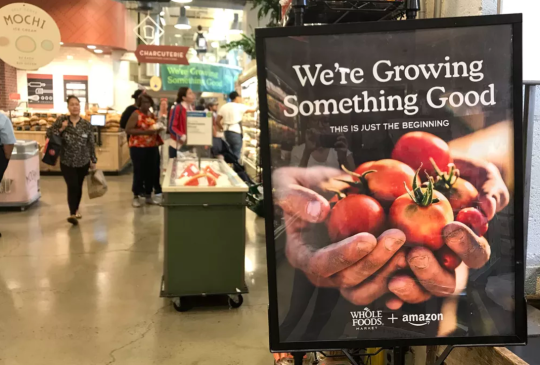
Amazon’s announcement that it would slash prices on select food products at Whole Foods was the first sign of how the e-Commerce giant plans to run the grocer, but it also leaves plenty of questions open as to how Whole Foods will operate in the future.
As of Monday, Aug. 28, Amazon reduced prices on select items. At a midtown Manhattan location, price cuts ranged from 7% (large brown eggs) to 43% (organic Fuji apples). At least nine items were discounted beyond 29%. Some locations also hosted and sold Amazon devices such as the Echo and Echo Dot.
The RTP team discusses the pricing changes and debates whether they will be enough to lure new customers. Additionally, the editors discuss the potential ramifications of the price cuts, such as potential changes in product quality and price hikes in other areas.
Debbie Hauss, Editor-in-Chief: In some ways I think this pricing tactic should be most terrifying for the execs at Whole Foods. Yes, there are a lot of jokes about how much more it costs to shop at Whole Foods, but the brand’s stock value has been steady or rising since 2015. As with Walmart’s purchase of some different, more nimble and unique brands, if Amazon puts its finger down too hard on Whole Foods, then the brand image may be permanently damaged. So far, from my personal experience, I think this tactic was rushed to market too fast without a lot of planning. It was more of an overall message to the market than anything else. I checked it out on the Amazon Prime site as well as on the Whole Foods site. On the Amazon site there was a statement but no clear call-to-action that I could find easily. On the Whole Foods site there was no mention of Amazon Prime whatsoever. When I tried to search one of the products that had been touted as featuring a lowered price, it either didn’t come up, or it came up with no indication that anything had changed. I’ll continue watching as a reporter and consumer, but I am not impressed by this first effort on either front.
Adam Blair, Executive Editor: A few years ago, when gas prices were on a continual upward climb (a time that coincided with a long commute to work for me, but them’s the breaks), I remember reading that one reason such prices frequently became a political issue is that they were so visible to consumers on a regular basis. Shoppers can practically see gas prices changing before their eyes. So while I’m happy about the Whole Foods price cuts, I’m also more than a little skeptical about them. Grocery is a thin-margin business, and unless Amazon is willing to run Whole Foods at a loss (and never say never about anything Jeff Bezos might do), lower prices in one area will almost always be balanced by higher prices — or skimpier services – in another area. But for the moment let’s celebrate that “Whole Paycheck” is morphing into “Two-Thirds Paycheck.”
Marie Griffin, Managing Editor: Remember that Amazon measures its success “in terms of the metrics most indicative of our market leadership: customer and revenue growth, the degree to which our customers continue to purchase from us on a repeat basis, and the strength of our brand (Letter to Shareholders, 1997).” Margin isn’t on the list, but Whole Foods’ lower pricing fits because it is designed to grow customers, revenue and shopping frequency. Most significant of all is that Whole Foods gives Amazon another lever into the business it most wants to dominate right now — food. Grocery chains, including Walmart, must respond quickly and decisively. Don’t respond by sacrificing your margins. Amazon has huge-margin businesses like Web Services that can offset short-term losses at Whole Foods. Sidestep. Focus on your strengths and differentiate. Think of the long term, like Amazon. And get ready for a battle that has only just begun.
Glenn Taylor, Senior Editor: I think the news of Amazon purchasing Whole Foods was enough by itself to drive more people to Whole Foods stores out of sheer curiosity. Now that certain price cuts are being publicized, the brand’s popularity will increase. As far as quality goes, Amazon hasn’t really skimped on any major products/services they’ve offered, nor have I heard complaints about things taking a turn for the worse under their umbrella. I guess the Fire phone was a big dud for them, but the company has a habit of improving on their offerings regardless of pricing. I see the same happening with Whole Foods, where they will sacrifice margins but expand the brand while doing it. With total Q3 sales increasing a paltry 0.6% and comparable store sales decreasing 1.9%, it’s clear that driving customers back into Whole Foods stores will be the lead priority, regardless of costs.
Klaudia Tirico, Features Editor: I don’t have anything negative to say about Amazon’s initiatives to lower Whole Foods prices, as I don’t see any dangers in quality declines or potential backlash from customers. If it means that more people will have access to healthy, fresh foods from Whole Foods, it’s a win for me. I was pleasantly surprised at the new lower prices that started on Monday — Business Insider reported that prices of a collection of items dropped nearly 23% at a specific Whole Foods location. That’s a pretty big deal, especially for average Americans who can’t always afford to shop at the retailer. I’m excited to see how the partnership evolves, but for now, it’s worth taking a trip to Whole Foods (even if it’s just for cheaper avocados and bananas).






